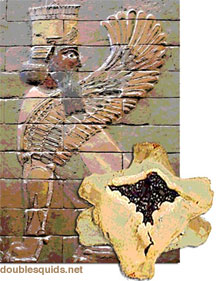
Purim is one of the most Persian of Jewish festivals.
The story is essentially about how Haman, the Amalekite vizier (not a Persian), tried to abuse his power to massacre all Jews and how this was thwarted by the courage of the Jewish Queen Esther, the wisdom of his uncle Mordechai and the decree of the King Achashverosh of Persia (usually identified with Xerxes) who commanded that Haman and his offsprings be executed on the same platform they had prepared for Mordechai.
According to the story, Kings of Persia and Media could not revoke an older decree, so to prevent the murder of Jews, the King had to issue a new decree to allow Jews to defend themselves for two days against the gang of anti-semite hooligans that were attacking them following Haman`s earlier decree. The story is essentially about Amalekites and Jews.
Who were these Amalekites?
Amalekites were a tribe in western Arabia who had attacked Israelites coming out of Egypt in the time of Moses. Unlike others, they had attacked from behind the moving caravan, killing old men and women and children and pregnant women who walked slower than others. From then on Amalek had come to symbolize the anti-Jew. Later King Shaul, the first king of Israel and Judah failed to destroy Amalek entirely as God had commanded. So he lost his kingship to a young shepherd and lute player David. As the story goes Amalek had since then been scattered among all nations using its nefarious influence to bring the host nations to hate Jews and annihilate them.
In the Book of Esther many years has passed and Haman, the descendant of the Amalekite king Agag, has reached high political status in the Persian empire. His ancestral hatred of Jews is rekindled when Mordechai , the Jew (of the same tribe as King Shaul) refuses to bow in front of him. According to Talmud Moredechai does not bow to the Amalekite Haman, because of the images of idols and gods that were depicted on his breastplate. Symbolically it speaks of how Jews refuse to accept the false authority of the their nemesis. Finally Mordechai and Esther, by the intervention of King Achashverosh of Persia, finish what their ancestor King Shaul failed to do ages ago.
Persia is the setting of the story and the story ends well when the Persian king, which in more mystic interpretations of the story symbolizes God, saves the Jews out of his love for his Jewish queen who symbolizes israel. The Bible is very clear that Haman was not Persian, that when the inhabitants of the city of Susa heard of Haman`s decree they were dumbfounded, and that Jews had a prestigious position in the Persian society as Haman`s wife once reminds his husband. The story ends with Mordechai, Esther`s uncle becoming the grand vizier of Persia and helping to bring the land to prosperity. It is also interesting that in later years, under the Greek Seleucid rule, Jewish apocryphal texts refer to Haman as the Greek. In other words, Haman and the ani-semites depicted in the story do not belong to a particular nation, but to a specific `tribe` of Amalek which as time went by had come to symbolize the `anti-semite` of every generation. As the rabbis say, no nation is an enemy of Jews, only individual among them that are `mythlogically` seen as belonging to the `tribe of Amalek`.
Background
The story of Purim has very little historical basis if any. Instead it is the Bible`s archetypical tale of Jews in diaspora and the challenge of anti-semitism they face in every generation. Even so, just like the story of Koresh (Cyrus) and Daryavash (Darius) Persia is depicted in surprisingly favorable light, unlike any other empire that has ruled over Israel and Judah in Biblical times.
The story and its mode of celebration goes back to Babylonian feasts of Marduk and Ishtar (compare with Mordechai and Esther) and how they survived the underworld and replaced the evil gods before them. The celebration is a feast of costumes, masks and dancing. It comes from the same origin as that of pre-Nowruz festivities of `Pirouz` who also symbolizes Marduk coming victoriously from his journey to the underworld his face blackened by the ordeal. Just like Purim, the pre-Nowruz festivities are also replete with dancing and colorful costumes.
As is usual with the rest of the jewish scriptures, an older seasonal/cyclic feast is celebrated while a relevant historical/anti-cyclic jewish theme is superimposed upon it. For instance, after Purim comes the festival Pesach (Passover) which has the same origin as Nowruz, the coming of spring. The historical event chosen for it is the Exodus from Egypt. A new year, a new retelling of the Jewish history.
Anti-semites and Purim
Interestingly anti-semites in history show a deep interest for the story of Purim , that is their warped and twisted version of it. Nazi criminals like Julius Streicher were obsessed by Purim. He is known to have shouted out, calling the Nuremberg trials the `Purim Fest` of 1945.
This makes this little tale an alarmingly pertinent story for today when modern Hamans, ideological Jew haters with no linkage to Iranian identity, have once again taken power inside Persia, and together with their allies outside, are spewing their anti-semitic poison and lies, and preparing for yet another try at their age old desire of Jewish annihilation.
May they also reach the same fate.






